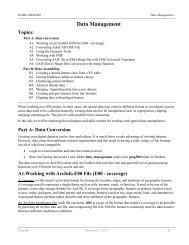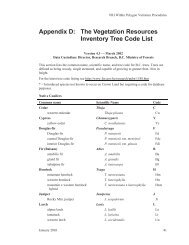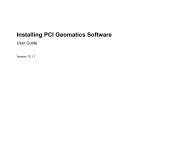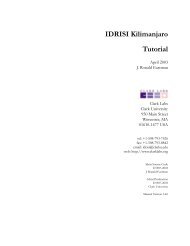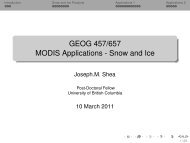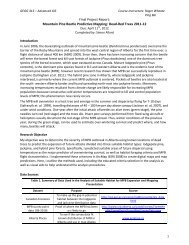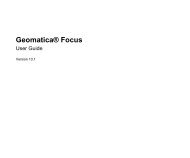Understanding Map Projections
Understanding Map Projections
Understanding Map Projections
You also want an ePaper? Increase the reach of your titles
YUMPU automatically turns print PDFs into web optimized ePapers that Google loves.
GEOGRAPHIC COORDINATE SYSTEMS<br />
A geographic coordinate system (GCS) uses a threedimensional<br />
spherical surface to define locations on<br />
the earth. A GCS is often incorrectly called a datum,<br />
but a datum is only one part of a GCS. A GCS<br />
includes an angular unit of measure, a prime<br />
meridian, and a datum (based on a spheroid).<br />
A point is referenced by its longitude and latitude<br />
values. Longitude and latitude are angles measured<br />
from the earth’s center to a point on the earth’s<br />
surface. The angles often are measured in degrees<br />
(or in grads).<br />
equal longitude, or meridians. These lines<br />
encompass the globe and form a gridded network<br />
called a graticule.<br />
The line of latitude midway between the poles is<br />
called the equator. It defines the line of zero latitude.<br />
The line of zero longitude is called the prime<br />
meridian. For most geographic coordinate systems,<br />
the prime meridian is the longitude that passes<br />
through Greenwich, England. Other countries use<br />
longitude lines that pass through Bern, Bogota, and<br />
Paris as prime meridians.<br />
The origin of the graticule (0,0) is defined by where<br />
the equator and prime meridian intersect. The globe<br />
is then divided into four geographical quadrants that<br />
are based on compass bearings from the origin.<br />
North and south are above and below the equator,<br />
and west and east are to the left and right of the<br />
prime meridian.<br />
The world as a globe showing the longitude and latitude values.<br />
In the spherical system, ‘horizontal lines’, or east–<br />
west lines, are lines of equal latitude, or parallels.<br />
‘Vertical lines’, or north–south lines, are lines of<br />
Latitude and longitude values are traditionally<br />
measured either in decimal degrees or in degrees,<br />
minutes, and seconds (DMS). Latitude values are<br />
measured relative to the equator and range from -90°<br />
at the South Pole to +90° at the North Pole.<br />
Longitude values are measured relative to the prime<br />
meridian. They range from -180° when traveling west<br />
to 180° when traveling east. If the prime meridian is<br />
at Greenwich, then Australia, which is south of the<br />
equator and east of Greenwich, has positive<br />
longitude values and negative latitude values.<br />
Although longitude and latitude can locate exact<br />
positions on the surface of the globe, they are not<br />
uniform units of measure. Only along the equator<br />
The parallels and meridians that form a graticule.<br />
2 • <strong>Understanding</strong> <strong>Map</strong> <strong>Projections</strong>




